Welcome, friends, to 2024’s edition of “Some Games I Played in [Year] and What I Thought Of Them”!
It has been a good year. This year I wrote and published what is by far the most up-to-date and comprehensive academic summary of Twitch and game live streaming you’re going to find (now out, and if you want to give it a look and buy it on Amazon, please consider leaving a review!) alongside publishing a bunch of journal papers too, such as these two on games podcasts and Twitch. Then in November, on the back of the last five years of my research I was also, to my absolute amazement, named by The Australian‘s annual Research Magazine as the most impactful researcher in communication / media studies / internet studies in the whole country, which is… an interesting development.
It was also, however, a year with a huge amount of game dev took place, that culminated in releasing Ultima Ratio Regum 0.10.3 (now 0.10.3b, with a bunch more bug-fixes, and more to come soon in a 0.10.3c). These are the final releases before 0.11 (coming 2025), which will contain what I think will be the first solvable procedurally-generated riddles ever made in a game (see this YouTube video if this is your first time here). It has, as ever, been a huge pleasure to work on the game, to hear what you all think about the developments, and to now be so very, very close, to releasing a version with a win condition – and indeed I plan on hosting a little competition when the time comes, but more on that later. Finally for this year, I also at last got myself on the property ladder (!) as the end result of a truly excruciating process, and subsequently completed surely my biggest achievement of the year: reading the first seven books of the Malazan Book of the Fallen. Of these, I think House of Chains is slightly my favourite so far, and The Bonehunters my least favourite by a large margin (took me almost six months to drag myself through it, while the others have been polished off within a couple of weeks each). I eagerly anticipate appalled comments about both of these controversial selections.
During these twelve months, however, by my count I spent time with ten games – two below last year, although some of these have consumed me for very substantial periods of time. It’s the usual mix of new and old, indie and blockbuster, and as usual I’ve written up a short review for each one, starting with my second favourite of the year, then going through everything else I played this year, and finishing with a much longer review of the game I enjoyed most in the last twelve months. Hope you all enjoy this write-up, and as ever, do leave your thoughts on these games in the comments, or thoughts on games you’ve played this year, or that I ought to try next year!
Returnal
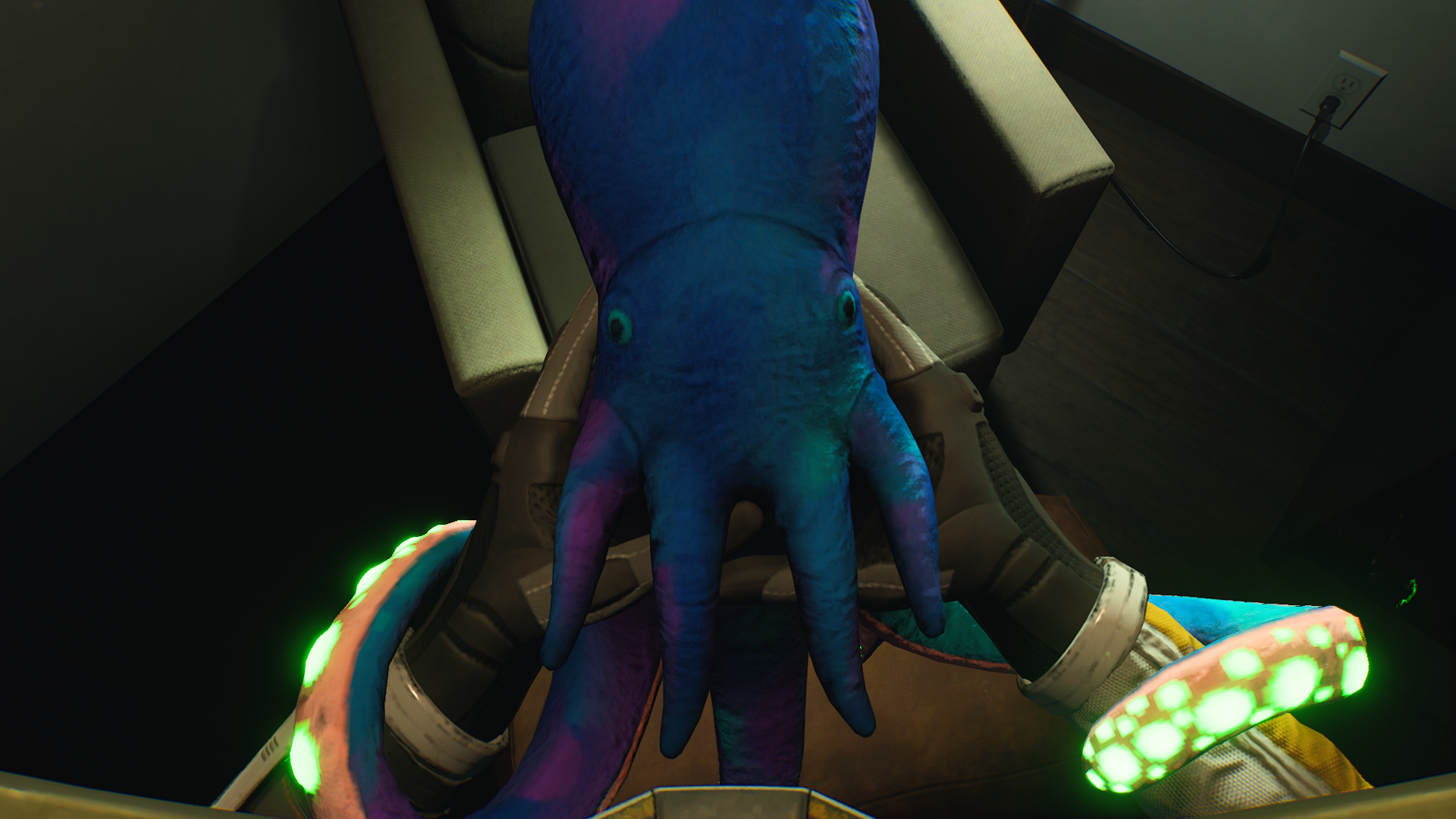
Returnal is one of the rare, rare times, that a big company actually demonstrates they know what they’re doing when they make a game with lots of procedural content generation in it. I adore From Software’s games, but Bloodborne‘s Chalice Dungeons are definitely not its strongest suit; I thought the new God of War was magnificent, but the Niflheim section didn’t exactly thrill. Returnal, however, absolutely knocks it out of the park. It offers the player a vast 3D world, freshly generated on each run, with magnificent visuals and incredibly fast, gripping, challenging combat, as well as a large set of interesting decisions on both the strategic and the tactical levels. They also do a great job of laying the PCG material in many different ways throughout the game, and it really generates that lovely feeling of “ah, so this run is going to be focused around X” when some interesting combination of things presents itself to you. What really stands out as well is that its aesthetics are truly stunning (and not at all reflected in the more light-hearted screenshot I’ve put in above), replete with megastructures, ancient ruins, vast expanses of nothingness and strange yawning chasms that are a sight to behold. The enemies, meanwhile, are delightful, very much channeling Zdzisław Beksiński (to whom we’ll return later in this blog post) to excellent effect. The game also goes hard in the Lovecraftian direction, with some of the descriptions of the enemies being incredibly unsettling and bizarre, while the core “bullet hell”-type combat in a 3D, third-person-shooter setting, is just so fresh and so compelling. I’ve put hundreds of hours into the game maxing out every weapon and every area, and completing all of the encyclopedia entries, and it never even remotely felt like a chore. The gameplay has such a high skill ceiling and the world is just so wonderfully rendered that I sometimes found myself doing that thing I sometimes do in From Software games when my gaming session for the day is done – just running around on the spot in-game, because I find it hard to leave such a deep, rich, grounded and compelling world.
Another one of the things that really stood out to me about Returnal was how cleverly the game handled its plot, striking a careful but very skilled balance between a number of different facets – especially the game’s depiction, as I read it, of madness, psychosis, and trauma. There is a lot of talk about how Hellblade is one of the best depictions of these experiences out there – and it may well be! It has been on my list a long while, though hasn’t yet been played. That notwithstanding, however, and while also acknowledging that depicting madness / psychosis / trauma are not Returnal’s primary objectives, I was actually blown away by this element. In particular I enjoyed the house sections, especially with the charming octopoidal kids’ toy (see above) – I won’t spoil specifics, the way that even something so safe and so treasured can suddenly be rendered alien and unknown and alarming was beautifully horrible, and that scene in particular left a lasting impression upon me, in turn within a wider sense of the character’s purgatorial existence, endless repetition, and desperation to escape the existence she has become trapped within. Of course though, no creative work is perfect and I do have a few quibbles, although it is testament to the strength of the game that these issues really are very minor indeed. For example, upon completing “Act 2” I wish the game hadn’t actually had a little information window that literally said “There’s still more to do” – yes, Returnal, I realise that! Thank you! I also wish this unnecessarily-hinted-at “hidden” ending had been far more hidden, as before it became available I’d been trying to figure it out, and then once made available it was actually very simple (though perfectly enjoyable) to hunt down. Similarly, one of the zones was markedly less interesting than the others, and I would have liked even more room variation – although I realise that when you’re making a 3D rather than a 2D game, that kind of thing is massively labour-intensive. Yet such things are utterly minor points, and even as a combination they only represent, at most, perhaps one hour of the now 100+ hours I’ve put into the game. A total joy, and a strong competitor for my game of the year.
Skald: Against the Black Priory
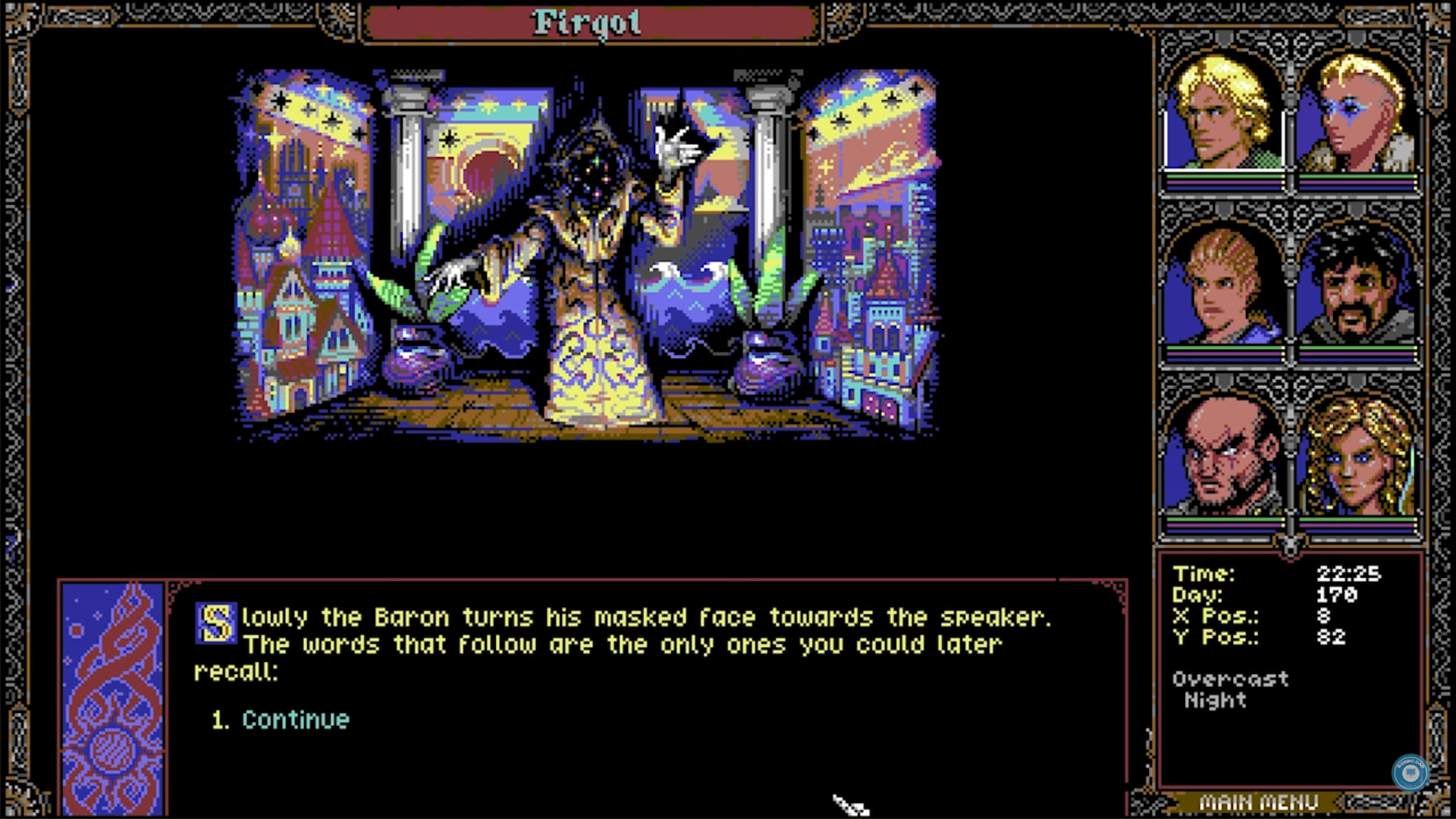
This next game was a rare case where I’d actually seen – and to some exam extent even followed – the game’s development on Twitter before it was released. I was really drawn to the artwork, setting, and the extreme sense of care and love which had gone into every aspect of the game (the same things which, of course, one always hopes are reflected in my own work!). This is a classic-style RPG set in a mix of a medieval and a Lovecraftian setting, which are brought together very nicely in a place called The Outer Isles. Here the player sets about searching for the answer to a number of bizarre and eldritch goings-on, as well as a number of interesting side quests and secrets and the like. I actually bounced off this game first when I tried it – it’s very much a love letter / homage to a particular time and era in digital RPGs, and although I was alive for at least some of it, I never in fact played these (e.g. the Ultima games – no relation, of course). In particular I found myself struggling with the combat, which was okay but I felt didn’t really at all take advantage of the possibilities of group-based combat, with most of the battles playing out in very similar and comparable ways (where were all the enemies we could have had with weird, unique abilities?!). Darkest Dungeon was a stand-out in this regard, with so many unusual mechanics and enemies which did distinctive or interesting things to your party or your build, as well as battles where the positioning of your party members and their party members were very important. Here, however, I did feel like the combat was the weak link. As compelled as I was by the setting and the visuals and the writing – which I’ll say more about in just a moment – I did bounce off it because of the combat, and the overall gameplay style was, as I say, for a subgenre I had no experience with.
However, I later returned to it to give it a second shot. I started to skim through the combat and the party mechanics, and focus on the other aspects of the game – and my goodness, I’m glad I did. I think the setting, story, writing, and art, of this game, are honestly all absolutely first rate, and bordering at some moments on the exquisite. Once I whizzed past the combat I found that I adored the time I spent in this world, talking to people, looking at things, solving the small number of little puzzles and mini-riddles the game had, and just becoming completely immersed in this setting and its fantastic homages to both medieval fantasy and Lovecraftian horror, as well as some other weird stuff I wouldn’t want to spoil. In particular, a quest – I think an optional quest, though I’m not sure – was an absolute standout. Without spoiling I will say that it involved a carnival and makes the Sheogorath quests in Elder Scrolls games – with which shares a little bit of DNA – look entirely banal, and like an insufficiently-deranged half-bacchanalian half-revel by comparison. I can’t sing the praises of this particular quest enough, and honestly rate it as one of the best quests I’ve ever played through in a game. The gradual buildup of tension anticipation was fantastic, the visuals were beautiful, the payoff was outstanding and bizarre, and overall I think this was really outstanding – and also because I appreciate the authors whose work inspired it. Overall then, some of the classic RPG aspects the game was harking back to didn’t really do it for me, and I do think the combat had way more potential than was realised here – this was exemplified when I encountered a “chameleonic” enemy, who then proceeded to do nothing even remotely weird or chameleon-like in our in our battle – but the other aspects of the game were superb, and I’m so glad I came back to it. If you were a fan of these 80s and 90s RPGs, absolutely give it a look – and even if you are not, I think it’s worth a shot for the fantastic writing and the fantastic art.
Scorn
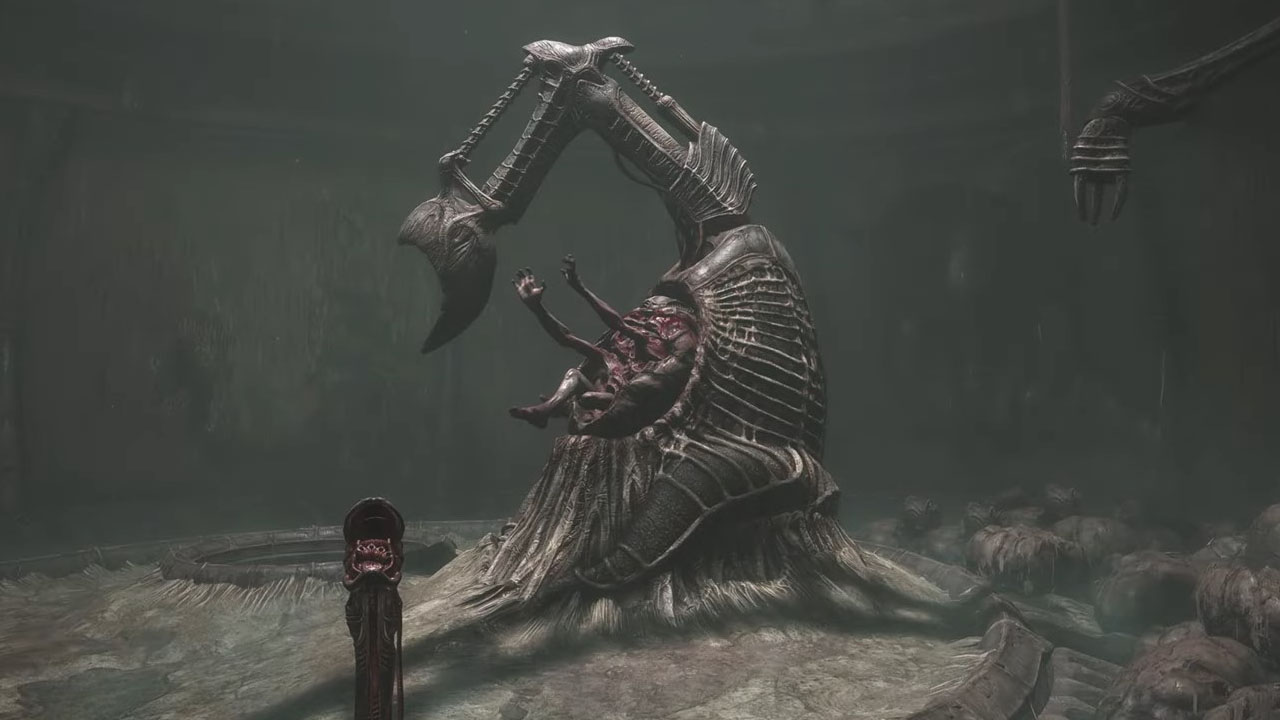
Like most people I’m a fan of the two original Alien films (were there others? I don’t think so) and Giger’s splendidly bizarre contribution to the work, though there are also far more obscure artists working in similar areas. One who stands out is the already-mentioned Zdzisław Beksiński (of whose work I was a fan before Stranger Things came into existence, a fact I feel compelled to state for some pathetic, insecure reason, that honestly doesn’t bear further analysis), whose work has some overlap with the Swiss visionary but also very much stands on its own. For those who aren’t familiar, Beksiński’s art focused instead on depicting exceedingly strange worlds rather than exceedingly strange creatures or objects. When Scorn first came into my radar, therefore, I was very interested. Plenty of games have tried to use that kind of style, but few were coming to the fore with anything like the level of attention and care given to the 3D modelling work, the overall aesthetic, and the atmosphere and lighting and shading work, that one saw in the Scorn trailers and promotional materials. I gave the game a look when it came out, and although it’s a short experience, I really enjoyed what I encountered and consider it time very well-spent. The visuals are extraordinarily strong, especially for such a small team – in this regard it put me in mind of something like Hellpoint, which is far less polished, but also a huge achievement for a small development team – and the world is a delightful nightmarescape, which leans strongly into biopunk and body horror for a genuinely unsettling and disturbing experience.
One of the things I enjoyed most was how the game poses so many baffling questions about its world. Everything implies other things, either seen on screen or never witnessed at all by the player, and the connections between things are always almost there for the player to grasp, but never quite apparent. It’s similar to a lot of the techniques used in the storytelling of From Software games, but taken to an even more extreme level – it’s a real challenge to get any sense of what’s actually going on here, but that’s certainly a deliberate part of the sense of disorientation and alienation and confusion the developers wanted the player (and the player character, within the game’s “story”) to feel. It feels truly and irretrievably alien, and it’s never clear whether we’re in the extreme future here, or an alien world, or a parallel universe, or a layer of hell, or the nightmare dreamscape of some eldritch abomination, or… whatever it might be. The puzzles are strange and slow and ponderous, but that’s never a bad thing, and their intense weirdness does a lot to emphasise the impossibility of understanding this world, and what you’re doing there. II found myself really captivated by the game, and hugely drawn in to trying to figure out what’s actually taking place. However, it wasn’t all good news – the combat was fine and quite intense, and reminded me particularly of some older games, but certainly wasn’t Scorn’s strongest suit. I was happy with its inclusion, but it definitely could have been a little more polished. The checkpoints were also very frustrating and often unusually punishing – particularly for a game which is mostly quite slow and meditative, and focused on lots of walking and exploring – and those ticked me off more than once. Ultimately, I’d say that Scorn reminded me intensely of Axiom Verge – a mix of the absolutely singular, wild, fascinating, glorious… and also the tiresome, repetitive, dull, and lacking in some modern game design pleasantries. I’m absolutely glad I gave it a play, and I just wish the developers had taken just a little more time to give the game a tiny bit more flow, either remove the combat sections or polish them heavily, and rework the checkpoints system into quite literally anything else. Nevertheless, this was an absolute winner I thought, and a wonderfully bizarre and stomach-churning adventure.
Loop Hero
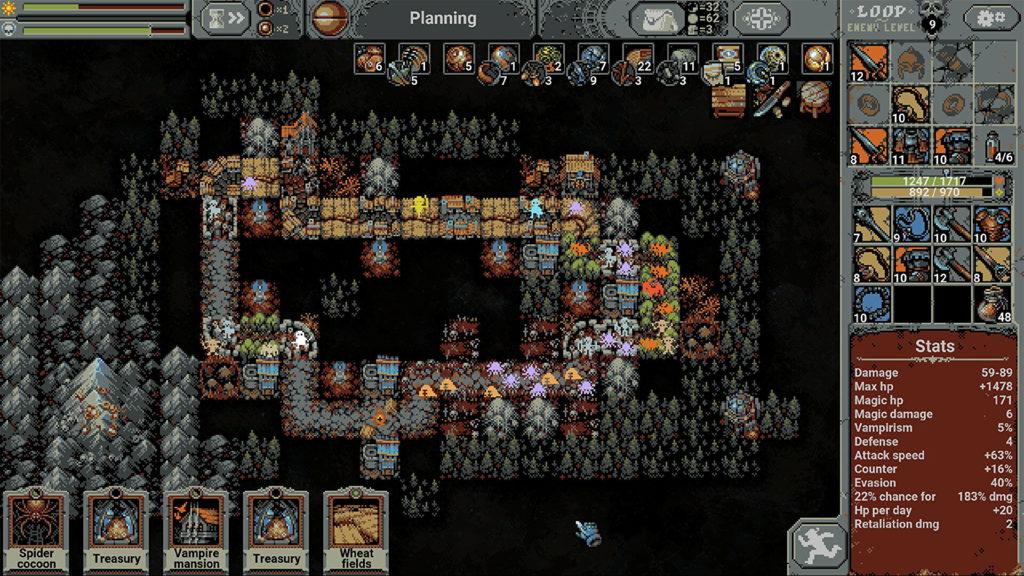
Despite my primary area of academic research being Twitch game streamers (e.g. here, here, here, here, here, here, here, here, here, here, and here, and also here as well) I actually don’t watch too much Twitch for leisure (!). The one streamer I’ve ever enjoyed so much that I found myself utterly unable to get bored while watching their channel is long retired from Twitch (though one lives in hope of a dramatic return one day), but there’s a constellation of around a dozen streamers I do tune into for leisure from time to time. Loop Hero hadn’t even been remotely on my radar until I saw one of them playing it on their stream back in 2021 – it looked intriguing and was visually just gorgeous, and I appreciated the unusual core gameplay mechanic and the balance between active and passive decision-making on the part of the player. When I watched it I naturally worried that the “sitting back” part of the game might bore me (as I generally like quite intense focused games – whether real-time or turn-based – that demand a lot from the player) but it turned up on sale on Steam a while back and I decided to give it a look. It’s an unusual game, and I now realise sits slightly within the context of the growing number of incremental and autobattler games which are becoming ever more popular, but essentially involves the player setting up battles and challenges for their hero to fight, with strategy and tactics emerging from the selections of items, fights, some classic “do I push one bit further or call it a day here?” mechanics, and so on.
Overall my experience with Loop Hero was pretty mixed, and I confess I called it a day after just a few hours. On the upside, the visuals are lovely, though I confess I actually really struggled with them. Since my head injury a few years ago – which happily didn’t mess with my brain at all, but really jangled my eyes – I have still continued to struggle from time to time with screen work, and unfortunately the visuals of Loop Hero really started sending my eyes funny. I often have this issue with a particular style of pixel art, often where there’s very little contrast between the colours, and colours which are quite muted, or when there’s a lot of detail stuffed into just a small number of pixels. Unfortunately Loop Hero hit all of these aspects, and I did find it hard to look at for quite a while – I think also the fact that you’re not doing things for part of the game also made it worse for me, because it allowed me to overthink and become self-conscious and self-aware about what my eyes were doing, rather than being lost in that world. Nevertheless, these are only I suspect quibbles which apply to me, but they did unfortunately reduce my ability to play and enjoy the game. Aside from this, though, the writing and setting are great, and ditto the music… but the visuals made it hard for me to stick around, and the autobattler elements are definitely a challenge for me – I just struggle to find excitement in sitting back while something plays out without my direct intervention. I always wanted to be taking more action and having a more active role in what was going on, and although the visuals are gorgeous, the combat just wasn’t all that gripping for me to watch, especially as battles started to get a bit more involved. This is one of those games I wanted to love, and while I can absolutely see how it would have a lot for someone else… sadly, I’m just not that person.
Into the Breach (Mods)
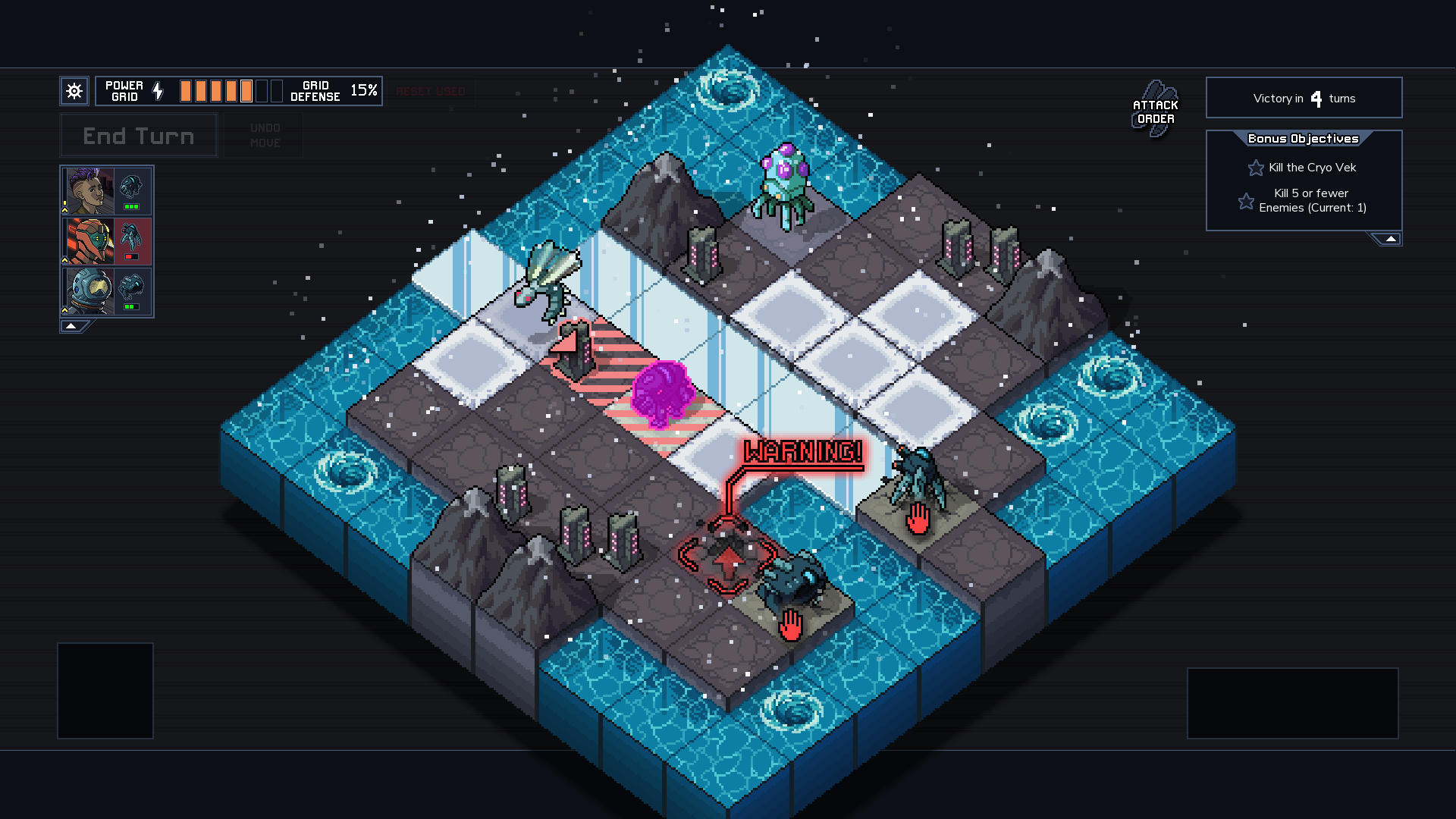
Why, dear reader, was I unaware until recently that Into the Breach has such an active modding scene?! I have no idea, but I’m so glad I finally discovered it this year. Once I figured out how to install the wretched things and get them working, I soon had two entirely custom islands on the go – one of which, a fantastic oceanic archipelago, is shown above – with entirely new graphics, quests, mechanics, artwork, CEOs, and other charming things (even additional dialogue, I think!). These were then coupled with over a dozen entirely custom squads – with, again, gorgeous artwork – that I selected from over a hundred, generally ignoring any squad that just used a recolour of an existing squad, even if its mechanics looked interesting. Generally the custom-art squads actually also seemed to have the most interesting mechanics though, which I think tells us something interesting about the overall commitment and dedication to these creative hobbyist projects. Anyway, the important point is that I have to say I was absolutely blown away by some of these squads – like many people, I think, I felt that the Advanced Edition squads were definitely interesting… but maybe not quite as interesting as they could have been? Their visuals were also, likewise, compelling… but maybe not quite as compelling as they could have been? I remember being a little disappointed when I read about what the new squads were able to do, and uncertain whether they’d really expanded and explored the possibility space of ITB as much as they might have. Subset Games are absolute masters of their craft, don’t get me wrong (the rest of the AE is absolute peak quality!), but I have to say that I think some of these modded squads outdo the Advanced Edition squads both in visuals and in gameplay.
Take, for example, the Paradox Core squad, whose central mechanic is based around bringing the past versions of enemy Vek into the present, where they can be damaged, and which also deals damage to the present versions of the Vek (as it would, logically). Or, take the Hydro Leviathans squad whose central mechanic is about creating and using water to deal damage, as well as having one mech – the “cargo” mech – with a totally unique mechanic involving capturing and later depositing a Vek somewhere else on the map. Or, take the really wonderful and novel Mercurials squad, who – inspired naturally by Terminator 2 – are focused on the idea of using liquid metal to both deal damage and heal their mechs, but it’s in limited supply, and enables the moving of health between mechs depending on which needs the most, and when. It was incredibly rewarding to find entirely new ways to play and new ways to interpret both existing mechanics and the additions brought along by the mods, and so neat as well to see how these all interacted with elements of both the base game and the Advanced Edition. As for the islands and the like, I could rave about these for hours, but the sheer level of detail here is what impressed me the most, with the two of these I played coming honestly quite close to total conversion mods (for a given island). I couldn’t be more impressed, and the addition of all their new graphics and new missions and new rewards and new units and everything else have breathed a tremendous amount of life back into a game I love, but had pretty much capped out in the base version. These are all just so impressive, and I recommend them in the strongest terms to any other Into the Breach appreciators out there.
Slay the Spire (Mods)
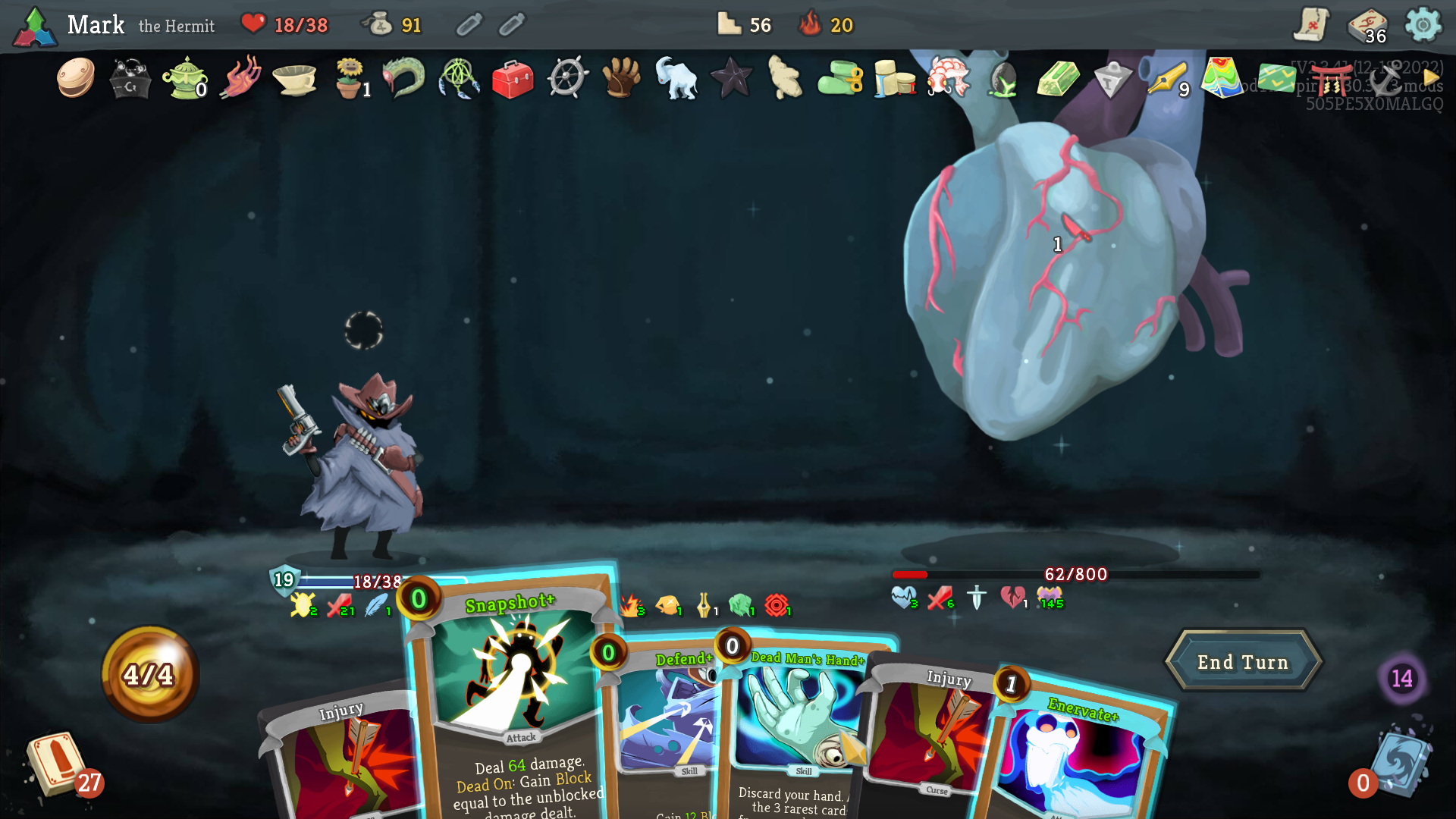
As well as Into the Breach, I’ve had a huge amount of fun this year with Slay the Spire mods. A few of them I’ve had difficulty getting to work, but the real standout has been the Hermit character mod. As above, I struggle to engage with mods that don’t try to reach the same quality as the elements of the base game they are replacing or emulating, and so lots of mod characters with art styles that don’t match Spire, or character designs which are out of place (or anime / manga, etc), I just can’t find it in me to play, even if the gameplay might be interesting. There’s just something too jarring about the artistic disconnect, and if I’m being honest, those sorts of mods do always make me question the extent to which I’m downloading a high-quality piece of work that has really taken the time it should to integrate with the core game. The Hermit, however, is the real deal, and I’ve been so impressed by this mod. I’d honestly assert the character is pretty much the same quality – in character visuals, card visuals, relic design, and card design – as the base four, and when the base four are all so incredibly good, that’s really saying something. The Hermit adds essentially three main novel ideas, which involve builds that focus on the default strikes and defends (which you want to remove from your deck when playing the other characters), builds focused on actually taking and using curses (which you’d almost never want as other characters, excluding rare Du-Vu Doll builds or deliberately taking the Pain curse as the Ironclad), and the new “dead-on” effect, whereby some cards have extra effects if they’re in the middle of your hand when played. I rarely wound up using strike/defend builds, but the other two were used regularly, and offered really interesting and novel possibilities. All these do introduce new considerations and ways to play, but the third of these is the most unusual, and suddenly changes your hand into something that requires attention in a way no other character demands. It’s a great innovation.
It was also interesting how my skill development played out with the Hermit. With most of the default characters I found myself hitting a number of plateaus and times of fast advancement – with most I got to around Ascension 5 (the game’s difficulty rating which scales up to 20) pretty quick, and then I got stuck a bit, and then I had new insights and pushed forward to around Ascension 15, then got stuck, then had some new insights and pushed towards to Ascension 20, and the “Heart kill” (defeating the optional extra end-game boss). My pattern with the Hermit was very different, though. For a few runs I really struggled to clear even Ascension 0 and Ascension 1 as I just couldn’t figure out how to keep the character alive, and how to deal enough damage to actually kill the bosses and the Act 3 elites… and then something clicked, and then I just zoomed from Ascension 2 up to Ascension 20 with, I think, only a single death. At that point, however, the Heart kill proved a real challenge – the Hermit seriously struggles with defence, and the Heart simply cannot be defeated without a strong defensive game to negate the Heart’s “Beat of Death” ability (you take damage for every card played), no matter how impressive your offence is. I think it took me six Hermit runs against the Heart to actually get the thing killed, with every time the beat of death whittling me down before I could scale up to the required damage output to get the thing killed. On the seventh or so attempt, however, it all came together, with a run that took me five hours (!) to complete, full of risk-taking and turns that demanded minutes of thought, lots of min-maxing, careful decisions and deck-building, and a well-earned final victory. This was a fantastic mod, and I honestly enjoyed it just as much as the base characters – fantastic stuff, so well designed, and such interesting build possibilities. Can’t recommend it highly enough.
I really can’t wait for Slay the Spire II.
Zuzatan: The Forgotten City
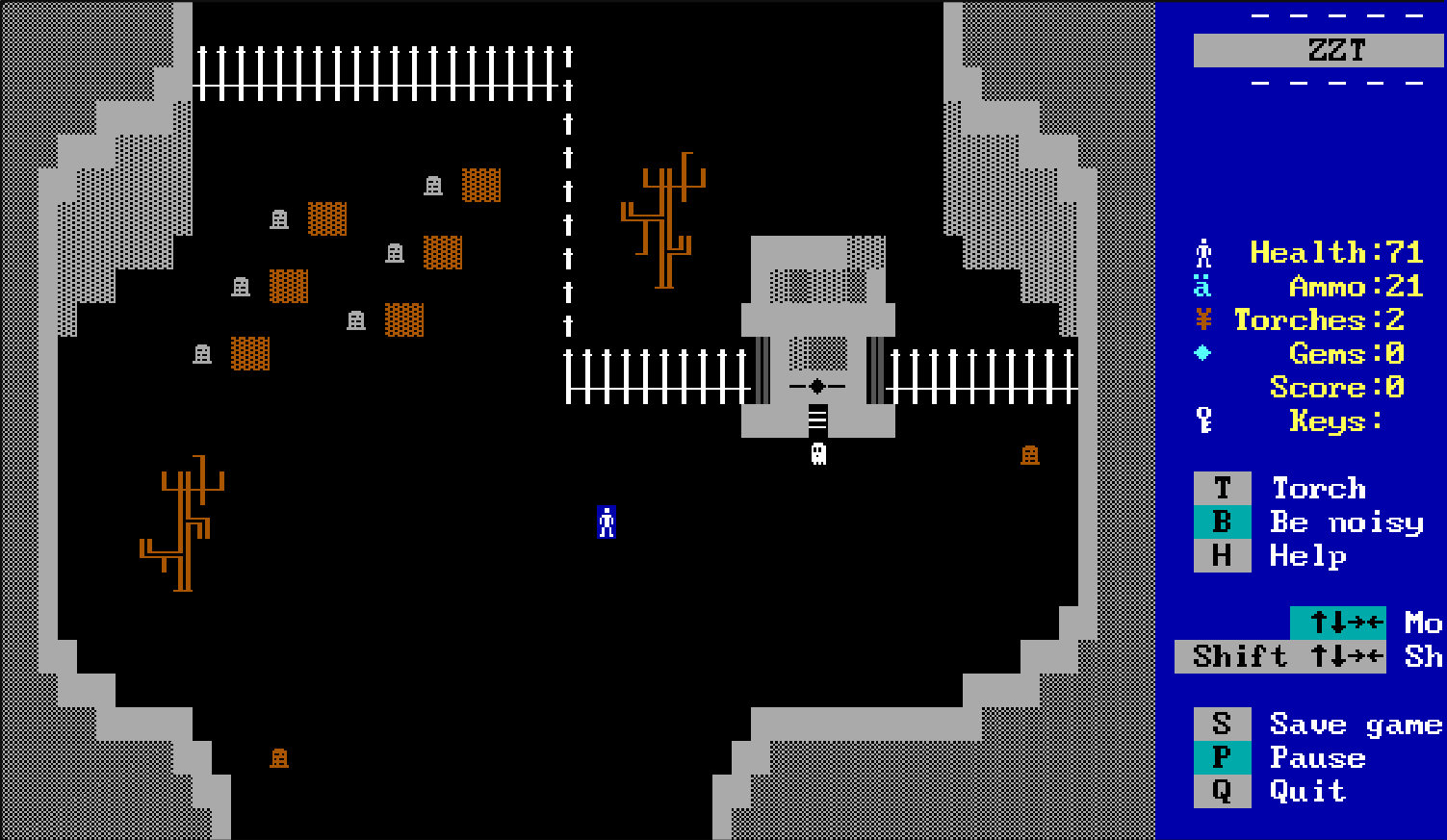
One of my real joys in life is watching blind playthroughs of the La-Mulana games on YouTube and Twitch. There are very few of these, and whilst most players do take a hint or two – which is entirely reasonable, I certainly required a hit or two on my first playthrough myself – I adore these, and find it absolutely fascinating watching different people address the puzzles in these games. What’s wild and so interesting to me is how every single person takes a different path through both La-Mulana and its sequel, and every single playthrough I’ve watched has players who find some puzzles trivial and others hard, but it’s never the same set of puzzles or the same set of riddles. Different people get caught on different things, different people infer meaning or importance into aspects which are irrelevant or trivial, and different people missed vital clues while spotting others. It’s incredibly interesting and is actually helping me with my own game design as well, by showing me the sorts of things that people can get caught on when trying to solve in-game riddles, and how instructions the designer clearly thoughts were clear (or at least, clear enough) can be misinterpreted, or misread, or glanced past too quickly to get their full import. One such playthrough that I really enjoyed recently, though, was the playthrough of one authorblues, which was a great deal of fun. However, I later discovered that he had subsequently designed a ZZT game influenced substantially by La-Mulana, and this of course grabbed my interest. Given how few cryptic riddle games exist on this earth, and how deeply I enjoy these games, I couldn’t possibly resist. This was Zuzatan: The Forgotten City, and I really loved my time with it this year.
To my joy, I discovered in Zuzatan a really fantastic homage to its chief inspiration, with some genuinely good puzzles that required a fair bit of note-taking. I never had to get a hint to complete it, nor to get the snails (play it and you’ll see what I mean), but I always enjoyed the couple points where I wasn’t completely clear on what the next steps were, and had to look back over my notes, do some thinking, and do some experimentation to find what might actually come next. A handful of the puzzles were very clear homages to La-Mulana, although sometimes with some twists or slight differences that I appreciated, while many of the others were very novel, while still iterating on some of the core riddle design ideas that these sorts of games have (and which I’m, of course, working on procedurally generating). The visuals were really nice and absolutely took advantage of the limited palette and the possible aesthetic style, and I was really impressed by the artistic creativity shown in displaying this world. As an aside, I’ve never actually played a ZZT game, so I don’t mind admitting it took me just a moment to actually familiarize myself with the conventions and the control scheme, but that wasn’t remotely a serious issue. Overall I’d rate its difficulty as a bit below La-Mulana 2 (which is below the original), but not too far below, and definitely a serious challenge if one isn’t used to these games. If you’ve never played a cryptic riddle game before, both this and the next game on my list would both be fantastic introductions to the genre. Zuzatan is a real winner, and helped to fulfil this year’s quota of cryptic riddle games that my brain requires on an annual basis. Great stuff.
Eldritchvania
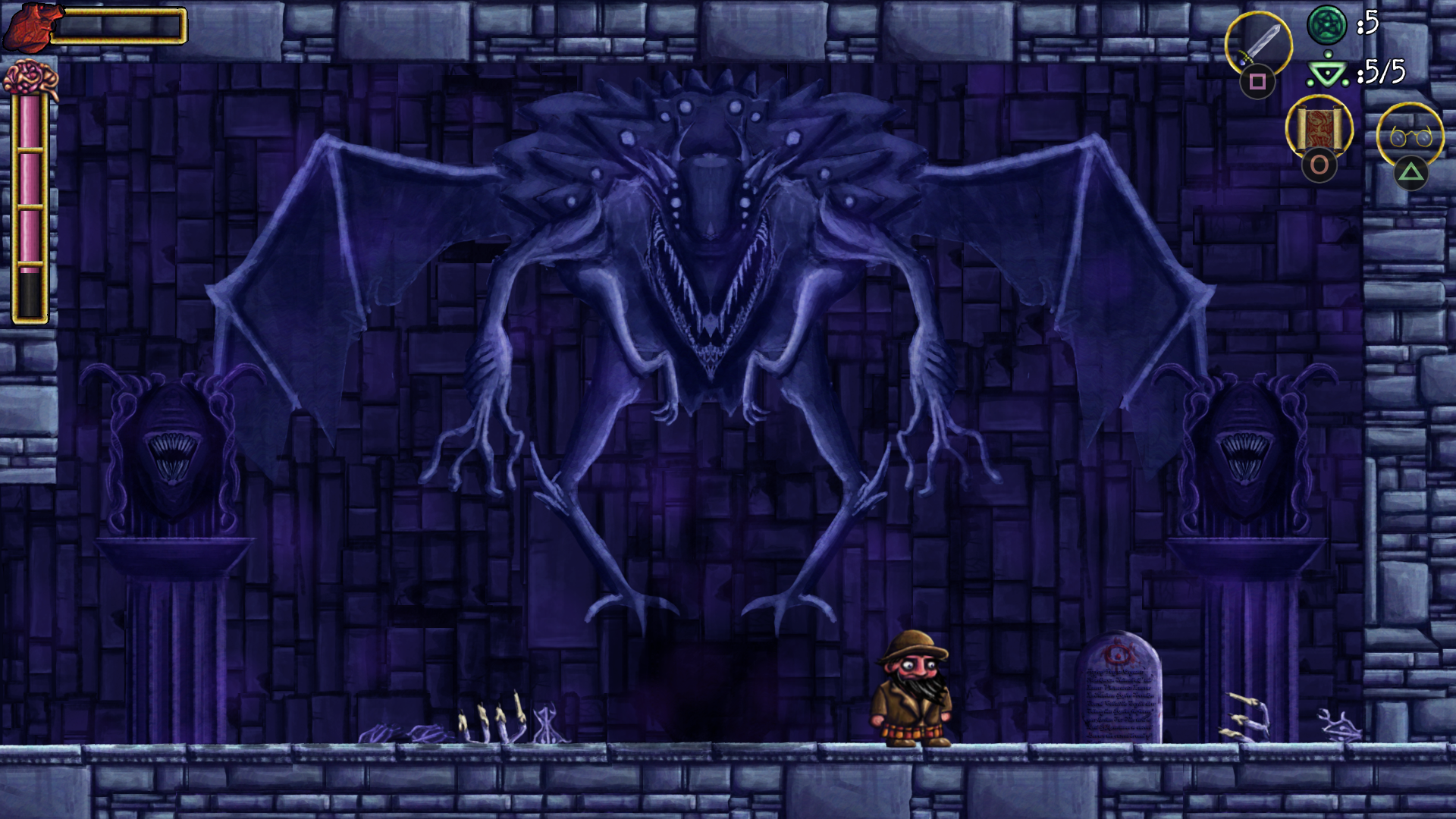
And now we come to another La-Mulana-like – and, again, it’s free! Absolutely ridiculous. I would, without exaggeration, have gladly paid $200 each for both this game and the previous one, as games of this sort are so extraordinarily rare and such an unusual and pleasing joy to explore. Whereas I discovered Zuzatan through a playthrough of La-Mulana, I discovered this one by simply dropping in to a Reddit thread about La-Mulana along the lines of “what other games are there like this?” and seeing mention of its recent release. All the others on that list I’ve either played or intend to play – Void Stranger and Animal Well are both on the list for perhaps next year – but this was a total unknown for me at the time. This one was again made by a very small team, and is more immediately like the game that inspires it, with a side-scrolling perspective, a map with a bunch of rooms in various areas connected in various ways, a certain degree of importance given to the world’s geography and layout, as well as a combat element alongside the core riddle solving element. I’m pleased to say that the riddles in the game were again excellent, required me to open up a notes file to keep track of a large number of things (this is essentially the metric of a good cryptic riddle game), and some of them had some really interesting and novel dimensions that, like La-Mulana, took advantage of the game’s mechanics in some unusual, surprising, and interesting ways. The ones that really stood out I don’t want to spoil here, but there was one ability the player later gains which quite literally made me clap my hands together in amusement, as it was so unexpected and so charming, and I really appreciated how well the game (especially towards the end) really rewarded the player who was properly paying attention to the world.
Other aspects of the game were great as well. The combat was simple but enjoyable, especially towards the later game when the player’s character became far more able to move around rapidly, dodge and respond to enemies, and so forth. One thing that really leapt out to me in Eldritchvania was actually the bosses, which like the first La-Mulana were in fact a highlight of the game for me (not, er… not so much the seequel. Not so much.). They were all, including the first “tutorial” boss, interesting and challenging and well-designed, and I definitely had a good time with them. There were some good minibosses as well, and while the underwater miniboss inevitably suffered just by virtue of being underwater, they were still fun, novel challenges. The visual design was also honestly first-rate, and I found myself totally involved in the world. The creature design particularly stood out here, but the environmental graphics were great as well, the different areas were very well distinguished, and nothing in the game world was unpleasant to look at. As a big Lovecraftian nerd, I also appreciated how closely the creators stuck to the established lore, and the extent to which I was able to actually predict creatures or gods who might appear later – and then they did! – was very satisfying, in a slightly sad and very fanboyish kind of way. The music, meanwhile, was also great and wonderfully atmospheric and just slightly offbeat, to the point that I’ve actually been listening to the OST while working on my own game design work. It really captured the Lovecraftian theme of the game, while also – importantly – being unobtrusive enough to not annoy the player while they’re spending a long time in a given area. Overall this is fabulous, absurdly cheap, and a real labour of love that pays off wonderfully. Highly recommended.
The Sorcerer’s Detritus
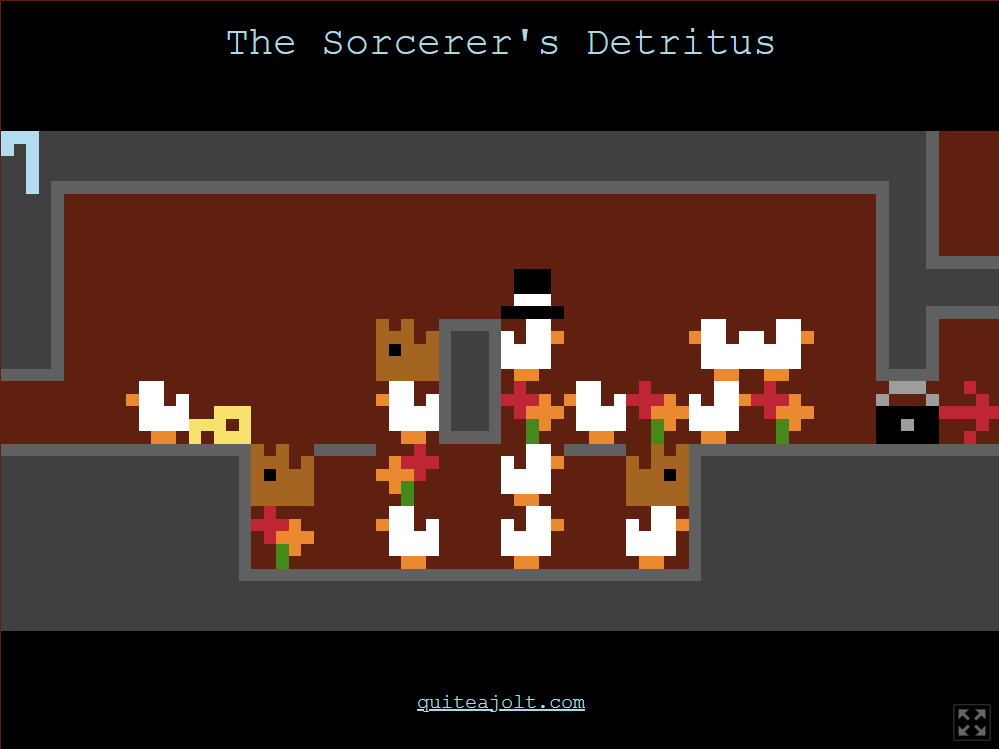
I really, really like Puzzlescript games. If I wasn’t myself pathologically incapable of creating a small game or working on a small project in any capacity, really – I did start URR in the same year I started a PhD, let’s not forget – I would absolutely whip out Puzzlescript and try to create something interesting and novel with it. Instead I content myself with enjoying the fruits of others’ excellent puzzling imaginations, and this year’s real highlight in this regard is the game The Sorcerer’s Detritus. I don’t quite now remember how I came across this one, but while I bounced off a few other Puzzlescript games without really getting into them, this one held my interest for the whole playthrough. Its name is charming, of course, and so is the central mechanic – you play as a magician’s hat, and you can continually fire out the eponymous detritus into the playing area, i.e. birds, rabbits, and flowers. These can be stacked or pushed, but cannot be deleted or removed in any way, which results in said detritus rapidly filling up each space. The game’s challenging levels are then all built around the idea of finding the required room to fit in the detritus needed to actually navigate – you can only “climb” by spewing out a load of stuff underneath you – and consequently move the key from the start of the level towards the door at the end, which cannot have anything between the key and the door if the key is to work.
For such a simple concept, small levels, and charming graphics… this is not an easy play. The levels very quickly become remarkably difficult, and do a very good job of presenting what seems like a very obvious solution which then, no matter how hard you try it, isn’t the obvious solution. As time went by I found it was much easier to try to think about areas of the game which could only possibly have one solution, work out what that solution is, and then try to work out what the interim or stitching-together elements of the overall solve would be in order to enable those disparate parts of the guaranteed solution to be successfully performed. On almost all levels its remarkable how fast the level fills up with waterfowl, lagomorphs, and the reproductive parts of angiosperms, and suddenly you find you don’t have any room to move and you’ve barely advanced the key across the level. Like many of these sorts of games, every single tile is required (in general) and this, again, can give a useful hint in some levels, but it’s still extraordinary hard. The later stages took me quite some time to decipher, and overall I think this is a real standout of the sort of innovative cool stuff you can get in Puzzlescript games – and one with a lovely and charming theme, as well, which is often a bit harder to do with such a limited palette and item visual size! Great stuff, very tricky, and a very good brain-teaser.
Tunic

Now we finally come to my game of the year for 2024 – Tunic. What an absolute, absolute gem this game is. Tunic places you in control of a charming fox (frankly that should be enough for game-of-the-year already) exploring an impressively large and astonishingly full world – especially given the size of the dev team – in pursuit of discovering the truth about the world he lives in. Much of Tunic – especially in the early game – is about combat and exploration, much like a lot of games which are at all Metroidvania-adjacent, and both of these are splendid. The combat starts off simple but becomes a lot more involved as you go along, and the bosses are actually a real strength of the game, always being dramatic and exciting, and surprisingly challenging at several points and definitely belying the cute aesthetic the game otherwise has. There are interesting items and tactics, a range of ways to defend definitely inspired by the Souls-like games, and some splendid music for the most exciting fights. The exploration is also a real delight, with the game taking full advantage of its distinct isometric viewpoint to hide a great number of interesting things, and like the best exploration games, regularly rewards the player for taking the time to look around, and experiment, and try things out. I’ve found before that with games housing only a few secrets it can be hard to encourage oneself to keep searching them out – whereas when there are things hidden everywhere, as in Tunic, the exhaustive seeker of mysteries is consistently rewarded, and keep getting that wonderful brain satisfaction of finding the hidden thing (whatever it might be).
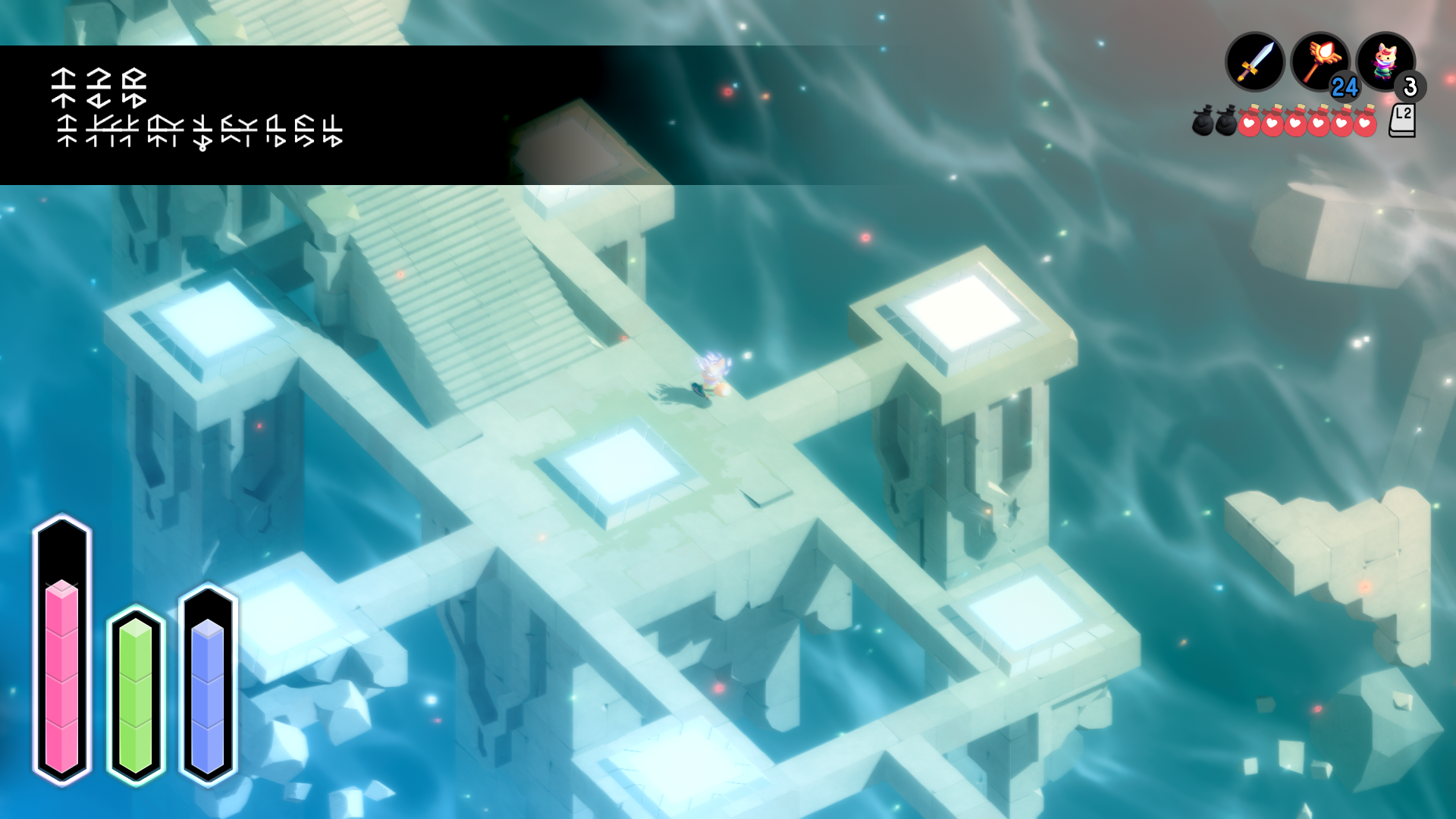
What deepens this sense is the fact that real joy of Tunic, ultimately, comes from the secrets – and their relationship to the exploration elements of the game. There’s an ending you can get to the game at the end of what appears to be the conclusion of the game (and after a very demanding boss fight, too), but then an entire second game of cryptic riddles, obscure clues, deciphering an invented language (and a far more complex one than the usual substitution ciphers one gets in games), really pushing one’s observational abilities to the limits, and piecing together diverse elements of information from all around the game. These were an incredible pleasure to explore, and several of them – upon figuring out the key or the particular element that would unlock the rest of it – made me laugh out loud with delight. I won’t spoil the specifics, of course, but these best ones are genuinely impressive and almost awe-inspiring in their ambition and their cleverness, and how wonderfully they are integrated into and hidden within the game world, so easily overlooked until you know exactly what you should be looking for. That moment – the discovery that there is more to the game than you thought, and that everything you’ve previously done in the game is only one layer – is a feeling I find incredibly delightful, and is certainly one I hope to and want to emulate in URR as well (being, as it’s becoming, a roguelike fundamentally about secrets, within secrets, within secrets…).
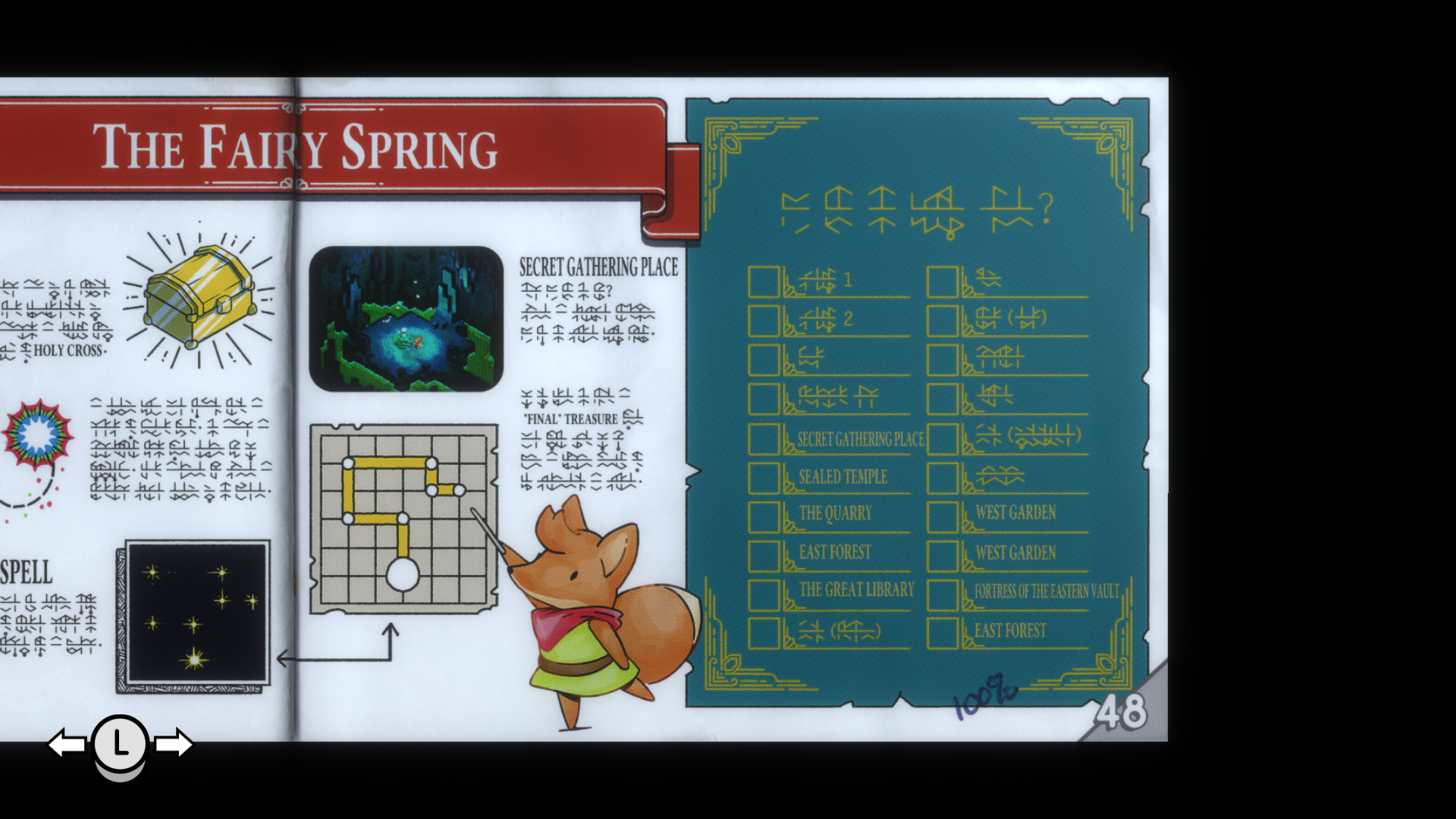
As part of this, we must discuss the manual. One of the really brilliant strokes of the game is to introduce an in-game manual… except in Tunic it’s a manual that has been scattered across the game world and thus needs to be collected, piece by piece, in order to shed new light on how you play the game and what sorts of things you can do. Even better, though, is the fact that the manual has been written in an invented language, apparently to emulate the sensation of getting a game as a child or teenager with the manual in a language one can’t read (for most players in the west, this would of course normally be Japanese) and having to figure out what the manual is talking about by using contextual clues like pictures, diagrams, numbers, icons, and the like. This is, honestly, a truly brilliant idea, and in some ways the cleverness and the novelty of this idea really lies at the very heart of Tunic. Again, I won’t go into spoilers, but figuring out what the manual is telling you is (on a basic level) just a delightfully interesting mechanic, but also goes into a deeper level the further you go into the game’s second-half riddles and mysteries in some really extraordinary ways. I can’t praise this mechanic enough – there’s something just delightful about a game with something you’ve honestly never seen before, and something which is really fully developed and explored as an idea as far as it can possibly go. As an aside, I accidentally spent a huge amount of time decoding the language before finding what I assume is the intended “key” to assist in said decipherment, and although it was very hard work, I adored the challenge. I have no regrets for jumping the gun on that one, and accidentally skipping the easier path! Next time I need a new hobby, I think deciphering Linear A will suit me just fine.
The next thing to talk about in Tunic is the game world. I adore animals in real life (as an aside, I’m eagerly looking forward to generating URR’s wildlife, but that’s a 0.12 or more likely 0.13 objective) and I don’t mind admitting that one of my favourite parts of Tunic is just the extraordinary charm the entire game exudes, and the fact one plays as – to quote the game’s tagline – “a small fox on a big adventure”. Your character is just so charming and so endearing, and a huge amount of effort has clearly been put into their animations and their physics, and making sure that this is a character the player is very happy just being, even if one might not be making all that much progress in the game at a particular moment. This is reflected in the world as a whole, which is beautiful, and it’s one of those game worlds I enjoy spending time in, even if my actions are not especially directed or deliberate. The aesthetic is in some ways very similar to some other games, but also in other ways really stands out as its own thing, and the artistic style is definitely pushed to its limits throughout the game world. The landscape and environments are lovely, the other creatures in the world with you are lovely, and the overall thing has a real buoyancy and joy to it one rarely finds in too many other games. For a game with so much combat and so many extremely difficult riddles and puzzles, the game’s world is so wholesome and homely, and I really appreciated the time spent to work this element into the game – in this regard it put me in mind of something like Hollow Knight, though for my two cents Tunic was far more successful at it. When you’re happy to just exist in the game without making even the slightest progress, you know you’ve found a rare gem.
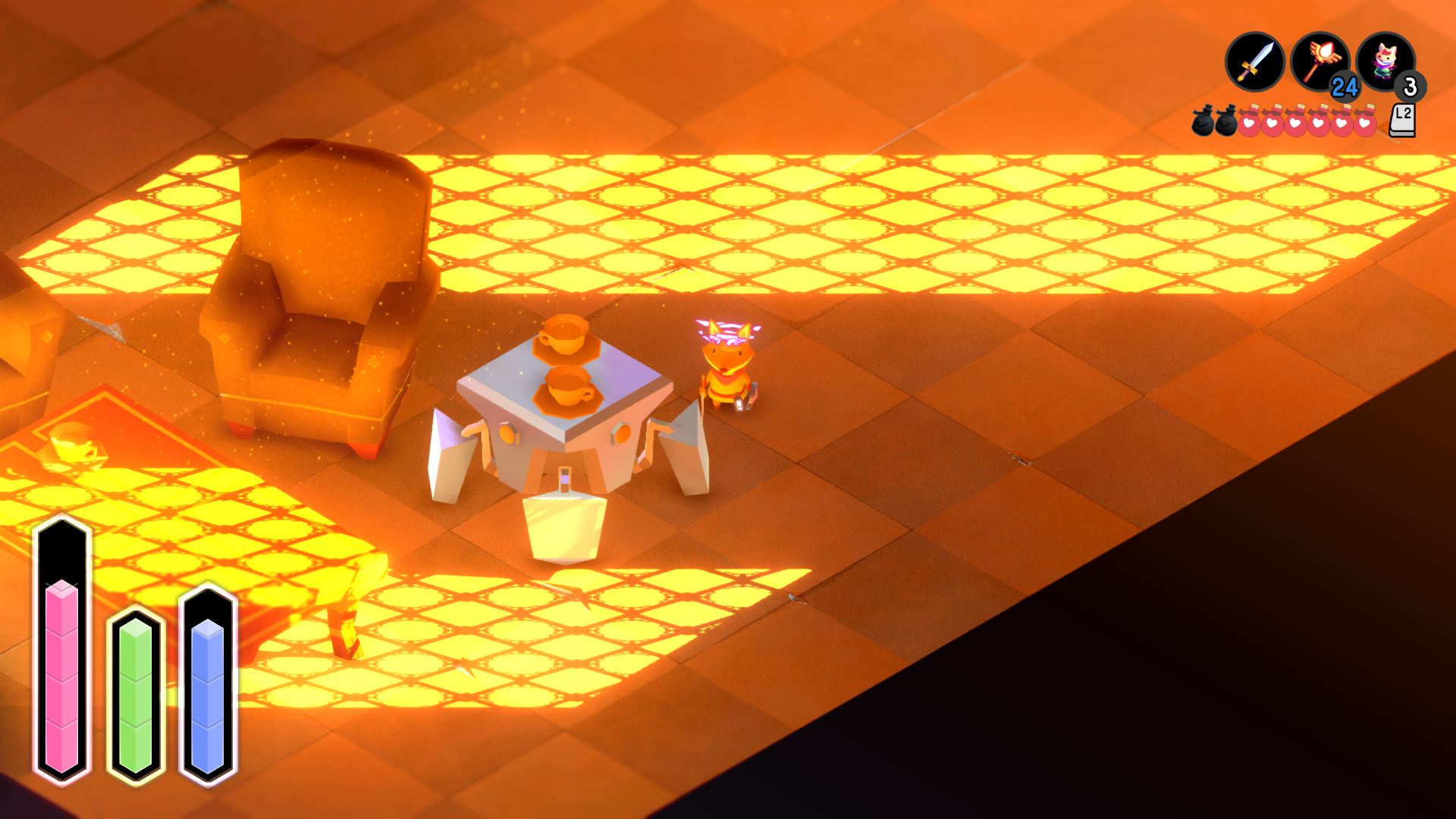
Tunic, then, most definitely earned its place as my game of the year. Returnal and several others came close, but I think Tunic simply has to take the title. Its world is too beautiful, its bosses too exciting, its exploration too rewarding, its secrets too satisfying, its manual too clever and too novel a mechanic, and its overall charm too utterly winning, to be ignored. The game was just a complete and whole experience, with no gaps or missing elements, nothing that was poorly developed or insufficiently implemented, and a size that is so much greater than what you think you’re looking at when you start playing the game. As I say, it regularly did that trick I do enjoy so much – hiding secrets in plain sight, until you know what you’re looking for – and the depth the game wound up having, where one just kept solving more, and more, and more riddles and mysteries… was an absolute delight. This is not to suggest all the visuals and combat and charm are not essential parts, as they absolutely are, but as with a game like Environmental Station Alpha, Tunic skillfully combines two games (Metroidvania, and La-Mulana-like) into a single game, to massive success. I’ll honestly always remember the time I spent with Tunic, and I genuinely sometimes even now just reload the game and wander around, finding it remarkably calming and centering, and a safe zone apart from the rest of the world (given some of the later-game revelations, that feeling actually has an extra level to it, but I wouldn’t want to spoil the mystery quest). Tunic is fabulous, and I cannot recommend it highly enough – just don’t read any spoilers, and have your notepad and print screen function ready to go!
So there we have it!
Thanks for reading everyone! I do hope you all enjoyed these little reviews. As ever – what did you all think of the games I also spent time with this year when you played them? What were you playing last year? What should I be playing this year? As noted above, Animal Well and Void Stranger are both on my list (though chances are I’ll only do one next year and the save the other for the year after). I also anticipate Balatro being a key game for 2025, and ditto the Cube Escape games, which recently caught my attention and intrigued me a little. Ultimately, though, I just play whatever takes my fancy, and I always have a clear feeling when the time has come to play a particular game, so we’ll have to see how 2025 plays out.
Thanks also, everyone, for being blog readers in this year, and I hope you all know how much I appreciate you. Thanks again for reading, and I’ll see you in three weeks for the next development update!
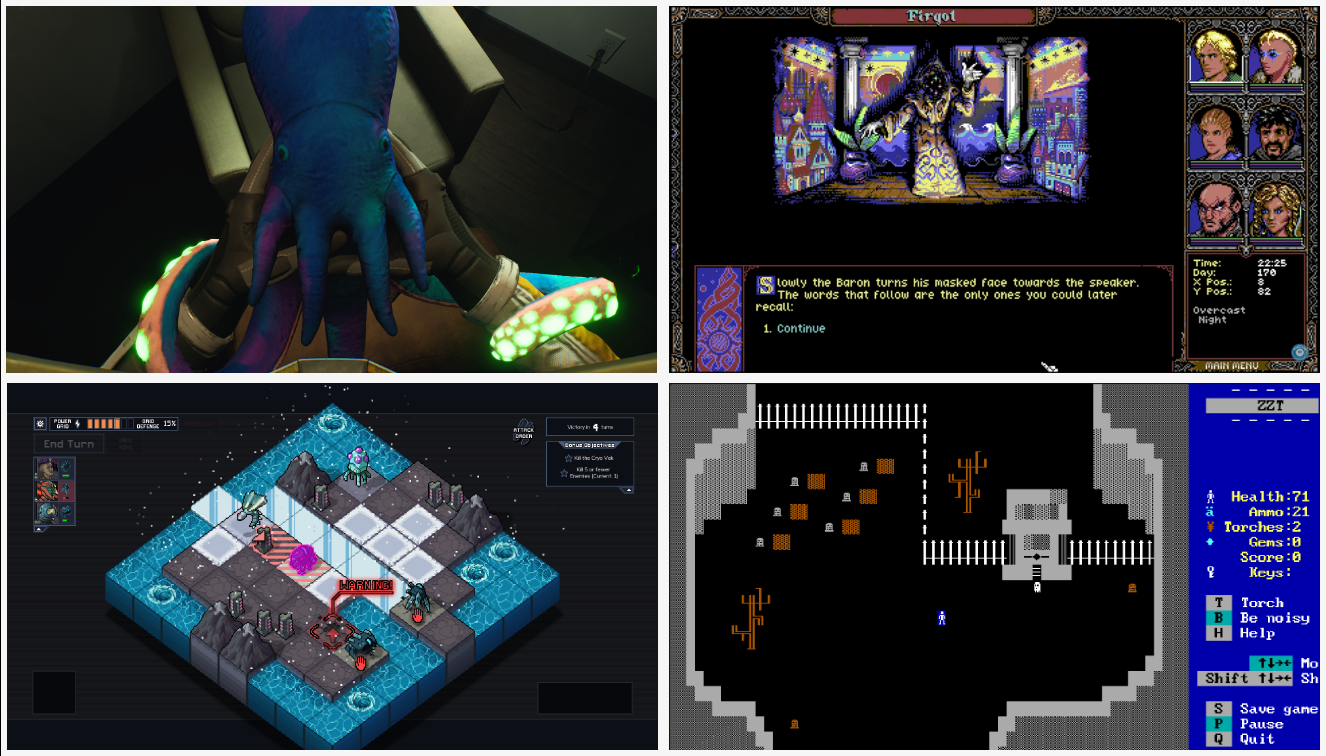
Happy new year, Mark! I always look forward to these 🙂
Tunic is really good – I played it closer to its release and didn’t finish the second ending/layer of the game, but even just beating the game through the main boss was wonderful with the exploration (in the world and with the manual).
I tried La-Mulana last year but bounced off at the time due to the controls: the biggest thing right out of the gate was the jumping, which felt too slow to me, and I didn’t like that you can’t control your jump in midair. It’s an intentional design decision, and it’s more realistic (and I’m sure you get more movement options later), but it was grating to me at the time. I’m sure I’ll come back at some point.
I played Balatro near its release…I wasn’t a huge fan, for a similar reason you have to Loop Hero: it felt like it was a lot more passive/just sitting back and watching your powers activate themselves. And I don’t really like games that are literally “just make the number get bigger.” Slay the Spire is a good example of the other end of the spectrum, where deckbuilding (strategy) and individual fights (tactics) are both actively engaging.
If I have one recommendation, it’s the board game City of Six Moons. It’s a deck of (custom) cards, some wooden tokens, and a rulebook written *entirely* in an alien language (not a substitution cipher at all), with some designer commentary accompanying the rulebook. The designer has an FAQ video, but that’s about all I’d look at. The one wrinkle is that they’re a tiny company in the US and don’t ship overseas themselves, but that doesn’t make acquisition impossible.
Thank you Henry, you too! Yeah, Tunic is a real winner – I was really blown away by it, especially with such a small development team as well. While I would never anticipate URR going beyond just me – unless I do one day hire a pure coder to help with things like code efficiency, prepping it for Steam, etc – I’m always impressed by how much a very compact group of people can achieve. Re: LM, you’re entirely right, the controls are very strange and unusual, though as you rightly say, it’s a totally intended decision. If you do return to it, my advice would be to never look at a single spoiler, ever. I sadly did take a few hints, but that’s because I didn’t really understand what the game was unless I was part-way through it, and robbed myself of some parts of a truly unique experience. As they say – don’t make my mistake! And have a notepad, or a large Paint or Word file, handy…
Balatro, interesting – much like you, incremental / clicker games are not my thing, but I’ve actually begun some play and having cranked it up to the gold stake difficulty, I’m enjoying it so far! As you say though, I don’t think I have much interest in going beyond the “core” game, i.e. getting to a point where you have to push towards an incredibly optimized build. But again, it’s still early days, so I’ll have a full report in around 365 days from now. So far though, there feels like a gulf of difference between white stake (clicker / incremental) and gold stake (much more deckbuildy / strategic / tactical), but we’ll see…
City of Six Moons – a quick Google later, and, wow, thank you so much for this recommendation. Looks fascinating. I’ll find myself a copy. Thank you!
Holy moly, a list of games that I am actually entirely bereft of any first hand experience with. Now that IS novel. Tunic, La Mulana, and Loop Hero are all on my wishlist, though!
I can’t get over how your text-based gushing can be so powerful at driving my desire to purchase games, though. Normally that’s something watching a person play a game does to me, but only if they’re genuinely enjoying it. Never before has a person writing about a game sold me on the game before. So an applause is in order!
Also, I’d never seen the video on Roguelike Celebration before, that was a dead fun watch!
Hahaha, thanks so much Conor! Those are three great games to consider, and as I mentioned in my other reply, make sure to avoid spoilers for LM if you can possibly help it; it’s a really unique, one-off thing, and I wish I hadn’t taken the few hints I did. More generally though, I’m very grateful for the kind words – I did do a little bit of actual game reviewing back in the day for a couple of publications, and although soon my academic and game dev lives took on such prominence that I just didn’t have the time to continue (and, of course, games journalism is dying in the 2020s anyway), it’s lovely to hear you enjoyed the read! Genuinely appreciated.
And, glad you like the RLC vid. It was hugely fun doing it live too, some of the responses in the chat were honestly very flattering and very humbling, especially coming from professional game devs and the like. I haven’t submitted on the most recent cycle, but I’ll probably be pitching for 2025 or 2026 again…
Thanks for the game reviews — I always enjoy reading these. Tunic had been on my wishlist for a while and I’d wanted to pick it up during the GOG winter sale, but sadly it wasn’t on sale…but lo and behold, shortly after you posted these reviews it went on sale there for half off, so I snapped it up! I’ve only played an hour of it but I love what I’ve seen so far. I’ll also check out some of your other recommendations, particularly Skald, Scorn, Eldritchvania, and Zuzutan.
The concept of layers of secrets is very enticing, and so I can definitely recommend Void Stranger to you. I haven’t gotten too far in it (I confess that some of the puzzle mechanics may be a bit beyond me) but I think you’ll enjoy it. I’ve also been playing a roguelike story game called Legerdemain (https://nathanjerpe.itch.io/legerdemain). And if you’re looking for more analog recommendations such as City of Six Moons, you might also enjoy The Curious Correspondence (https://mysteriouspackage.com/collections/cc/products/three-chapter-collections). I’ve been working through the puzzles with a family member over the past few months and we’ve had a blast with it.
Thanks for the comment crowbar! Fantastic you’ve got Tunic, I don’t think you’ll be disappointed at all. Void Stranger – absolutely, thank you for the recommendation, I’m excited to give it a look. Legerdemain is one that has been on the periphery of my awareness for a while, just by virtue of being involved in the roguelike world, but I’ve given it a proper look now and I think it could be something I’d definitely be interested in playing. Thanks for bringing it a bit more fully to my attention! And, re: TCC, also super interesting, thank you – I’ll be sure to give that a look too…
happy new year mark!!
Thanks nila, you too! 🙂